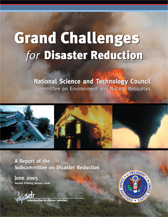|
The Subcommittee on Disaster Reduction
(SDR) is an element of the President’s National Science
and Technology Council and facilitates national strategies for reducing
disaster risks and losses that are based on effective use of science
and technology.
Mitigating natural and technological disasters
requires a solid understanding of science and technology, rapid
implementation of research information into disaster reduction programs
and applications, and efficient access to diverse information available
from both public and private entities. Chartered in 1988, the SDR
provides a unique federal forum for information sharing; development
of collaborative opportunities; formulation of science- and technology-based
guidance for policy makers;
and dialogue with the U.S. policy community to advance informed
strategies for managing disaster risks.
 |
To develop a ten-year strategy
for disaster reduction through science and technology, the members
of the SDR collaborated with scientists and engineers worldwide
to identify a suite of Grand Challenges for disaster reduction.
This document presents six Grand Challenges for disaster reduction
and provides a framework for prioritizing the related Federal
investments in science and technology. Addressing these Grand
Challenges will improve America’s capacity to prevent
and recover from disasters, thus fulfilling our Nation’s
commitment to reducing the impacts of hazards and enhancing
the safety and economic well-being of every individual and community.
— Dr. John H. Marburger, III, Director of the Office of
Science and Technology Policy and Science Advisor to the President |
A series of hazard-specific implementation plans prioritizing the Federal science and technology investment needed to reduce future loss of life and property as a result of disasters was developed in support of the Grand Challenges for Disaster Reduction, published by the SDR in 2005. Coordinated among Federal agencies, they list actions that agencies, in collaboration with individuals and organizations at all levels, must take in order to meet the Grand Challenges for hazard events such as coastal inundation, drought, earthquakes, floods, heat waves, human and ecosystem health hazards, hurricanes, landslides, technological hazards, tornados, tsunamis, volcanoes, wildfires and winter storms.
Recognizing that natural and technological hazards are inevitable and that disaster resilient communities experience minimal damage and disruption from hazard events, the Grand Challenges for Disaster Reduction Implementation Plans identify specific actions that will help the Nation become disaster resilient. Hazards may continue to occur, but by following this framework, prioritized Federal science and technology investment will help prepare communities and reduce losses.
|





